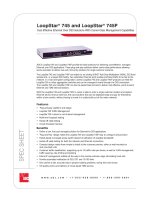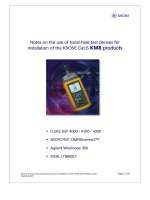Tài liệu KRONE - Guide - How to implement Cost effective CCTV at customer premises pdf
Bạn đang xem bản rút gọn của tài liệu. Xem và tải ngay bản đầy đủ của tài liệu tại đây (75.6 KB, 2 trang )
KRONE
facts
KRONE (Australia) Holdings Pty Limited
2 Hereford Street Berkeley Vale NSW 2261
PO Box 335 Wyong NSW 2259
Phone: 02 4389 5000
Fax: 02 4388 4499
Help Desk: 1800 801 298
Email:
Web: www.krone.com.au
Job No: 6164/04
How to Implement Cost Effective
CCTV at Your Premises
IP Convergence Spawns New Generation
of Security Solutions
Advances in technology now provide opportunities
for KRONE structured cabling products in solutions
outside of the traditional voice and data. The
Closed Circuit Television (CCTV) and security
market, previously dominated through the use of
coaxial cabling solutions, can now be provided for
by using far more cost effective structured cabling
solutions.
Post 9/11 there has been a dramatic increase in
the requirement for cost effective video surveillance
and security monitoring. Fuelled by this demand
has been the development of a number of
technologies to reduce the cost of implementing
what was previously projects requiring large
investments in both the active devices involved and
the passive infrastructure supporting them.
As a result of this requirement and other
circumstances, coupled with the ongoing march of
IP convergence, the result has been the
development of the so called 4th generation video
surveillance comprising IP multicasting, Digital to
Digital, pure IP based video systems. These solutions
provide digital communication based on TCP/IP for
high quality, full motion real-time video on standard
IP networks over Category 5/6 structured cabling,
fibre optic, or copper based xDSL, PSTN or ISDN
services for wide area, broadband access.
Key to 4th generation video surveillance systems
has been the development of an IP based
“Smartcam” which can provide for both a viewing
and control capability on the web based HTTP
protocol. IP multicast capability provides for viewing
and recording of security footage by multiple clients
simultaneously and securely. Lower cost, low
voltage smartcams enable video surveillance to be
employed at remote locations, industrial
environments, on board moving vehicles, or for
temporary staged, or seasonal installations such as
events, concerts etc. Indeed conversion devices are
also available which can IP enable legacy, analogue
based CCTV cameras connected in situ by a short
length of coax cable at one end and a Category 5/6
at the other. This can provide for most of the
benefits of a 4th generation video solution to
legacy camera systems.
As an alternative to IP camera based systems, for
legacy, non-IP CCTV systems or those requiring high
resolution/high frame rate monitoring systems for
highly secure, real-time environments like banks,
casinos, etc has been the development of “CCTP”
or CCTV over twisted pair. CCTV, up until now, was
reticulated through 75 ohm coaxial cabling
(typically RG-6). Through development in balun
technologies, it is possible to incorporate CCTV
signals into structured cabling systems. To apply
structured cabling connectivity to CCTV, a reliable
way is needed to adapt the video signal to the
twisted-pair cable. The CCTV balun is key to this
conversion. The CCTV balun is a passive element
that converts the unbalanced signal of the coaxial
cable to the balanced signal of the twisted-pair. The
balun must preserve a clear image quality over the
distance of a cable by providing immunity from
ground loop, hum and noise so as to produce
maximum video quality with minimum loss. The
twisted-pair cable has more signal attenuation than
the coaxial cable; hence the main factor necessary to
determine the maximum attainable distance is the
signal attenuation along the twisted-pair cable. A
higher performance category of cable means less
attenuation, i.e. Category 6 is better than Category 5.
Video or CCTV baluns are transmission devices
that provide a low cost means of sending live video
over unshielded twisted pair, point-to-point wiring
for distances of up to 305m (1000 ft). The video
baluns are compatible with all coax control systems.
A basic system consists of one unit at each end of a
twisted pair of wires. The video baluns are intended
for use over Category 5 structured cabling runs or
higher, to provide a convenient, cost-effective
alternative to coax. Most available baluns are
designed to provide immunity from noise and
interference, even when running next to line power.
As only one pair of wires is required for the video
signal, for simpler, fixed cameras not requiring
Pan/Tilt/Zoom (PTZ) active control, combined baluns
are available which can provide for up to four
cameras’ video signals to be sent down one twisted
pair cable. This allows for a very cost effective CCTV
cable deployment. For even longer cable runs,
powered (at the receiver end), active baluns are
available which can extend the distance up to 915m
(3000 ft).
Some balun systems provide controls to make
incremental adjustment of both gain and frequency
compensation to allow the system to be fine-tuned
for the twisted pair cable. Such features provide
adjustment for optimum performance over the
entire operating range and allow for cable length to
be estimated with a wide safety margin; when
bidding for CCTV twisted pair transmission jobs.
For camera systems requiring more complex
controls for PTZ and having inline power
requirements, rather than providing separate run
cables to each camera for this purpose, it is possible
to satisfy this by utilising the other available pairs of
a UTP cable, thus reducing the cable requirement.
Savings can be realised in lower labour and
material costs, smaller conduits, fewer cable pulls,
common media topology and easier retrofits using
existing cabling deployed for voice and data.
Structured cabling deployment of CCTV is
preferred by IT departments, who are increasingly
tasked with the responsibility of managing such
systems and who have knowledge of structured
cabling technology compared to coax. This results in
less training and special tooling requirements and
improvements in productivity for system
management. Moves/Adds/Changes (MACs) are
simplified due to the decreased number of proprietary
cables and cable pulls needed in a CCTV solution.
Overall there is significantly less redundancy in
infrastructure investment as structured cabling
deployed for legacy surveillance systems can be
later utilised for newer IP based cameras, other IP
based security or control devices and traditional
voice/data applications.
Using structured cabling for security solutions
also provides opportunity to solve potential
customer problems with other KRONE products. For
security monitoring in industrial or hazardous
environments, KRONE’s IP67 Industrial Ethernet
connectivity products are an ideal way to prevent
the ingress of moisture, dust and other
contaminants into the connection. Indeed these
products may also provide an ideal solution for
exterior mounted cameras and equipment.
Additionally for security equipment mounted up
poles, on roofs, etc which may potentially be
exposed to lightning hazards, KRONE Comprotect
products may assist in reducing overvoltage
damage to expensive surveillance equipment.
As security monitoring sites are in fixed locations,
the need for constant moves and changes is low;
hence patch by exception makes sense. Also as
excellent, connectivity transmission performance is
required for high picture quality, then KRONE’s
HIGHBAND products are an ideal solution. Whilst
HIGHBAND might seem to be a premium offering,
compared to the cost of a coax based solution, a
HIGHBAND Category 6 solution would be more
cost effective than coax; particularly where many
cameras are involved over long runs.
KRONE (Australia) Holdings Pty Limited
2 Hereford Street Berkeley Vale NSW 2261
PO Box 335 Wyong NSW 2259
Phone: 02 4389 5000
Fax: 02 4388 4499
Tech Support: 1800 801 298
Email:
Web: krone.com.au
Copyright © 2004 KRONE (Australia) Holdings Pty. Limited
Job No.: 6164 02/04
Example of CCTV infrastructure using structured cabling.









